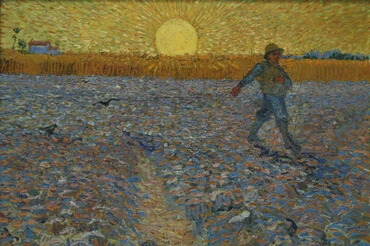Field

A "field" in the Bible usually represents the Lord's church, and more specifically the desire for good within the church. It's where good things start, take root, and grow. When you have a desire to be a good person and to do good things, the natural first questions are "What does that mean?", "What should I do?", "What can I do?". You look for ideas, concepts, direction. Once you figure out something you want to do or a change you want to make in yourself, you seek specific knowledge. If you want to volunteer at a food pantry, say, you'd need to know whom to call, when they need help, where to go, what to bring. Armed with that knowhow, you're ready to get to work. That process could be compared to food production. You start with a field -- which is that desire to be good. Then you plant seeds -- those ideas and concepts. Those seeds sprout into plants -- the specific facts and knowledge needed for the task (easily seen in the food pantry example, but also true with deeper tasks like "being more tolerant of my co-workers" or "taking more time for prayer," or "consciously being a more loving spouse"). Finally, those plants produce food -- the actual good thing that you go and do. The Writings also say that in a number of cases a "field" represents the doctrine, or teachings, of the church. This sounds markedly different. The desire for good is emotional, a drive, a wanting; doctrine is a set of ideas. But for a church to be true, its doctrine must be centered on a desire for good, and must lead people toward doing what is good. So sound doctrine is actually closely bound up with the desire for good.
Heaven and Hell # 180
180. Since angels wear clothes in heaven, they have appeared clothed when they were seen in our world, like the ones seen by the prophets and the ones by the Lord's tomb, whose "appearance was like lightning and whose clothes were gleaming and white" (Matthew 28:3, Mark 16:5, Luke 22:4, 24:4, John 20:11-12, 13) and the ones seen in heaven by John whose "garments were of linen and white" (Revelation 4:4; 19:11, 13). And since intelligence comes from divine truth, the Lord's garments, when he was transfigured, were "gleaming and white as light" (Matthew 17:2, Mark 9:3, Luke 9:29: on light as divine truth emanating from the Lord, see 129 above). This is why garments in the Word mean things true and the intelligence that results from them, as in John: "Those who have not defiled their garments will walk with me in white, because they are worthy; whoever overcomes will be clothed with white garments" (Revelation 3:4-5); and "Blessed are those who are watchful and take care of their garments" (Revelation 16:15).
Concerning Jerusalem, meaning the church as it is focused on what is true, 1 it says in Isaiah, "Rise up, put on your strength, O Zion; put on the garments of your beauty, O Jerusalem" (Isaiah 52:1); and in Ezekiel, "O Jerusalem, I have clothed you with linen, I have veiled you with silk, your garments are linen and silk" (Ezekiel 16:10, 13); and many other passages.
In contrast, someone who is not engaged with truths is said not to be wearing a wedding garment, as in Matthew: "When the king came in, he saw the one not wearing a wedding garment and said, 'Friend, how have you come in here without a wedding garment?' So that one was cast out into the outer darkness" (Matthew 22:11-13). The wedding house means heaven and the church by virtue of the Lord's union with them through his divine truth. This is why in the Word the Lord is called the Bridegroom and Husband, and heaven and the church the bride and wife.
Poznámky pod čarou:
1. [Swedenborg's footnote] Jerusalem means the church where there is genuine doctrine: 402, 3654, 9166.






